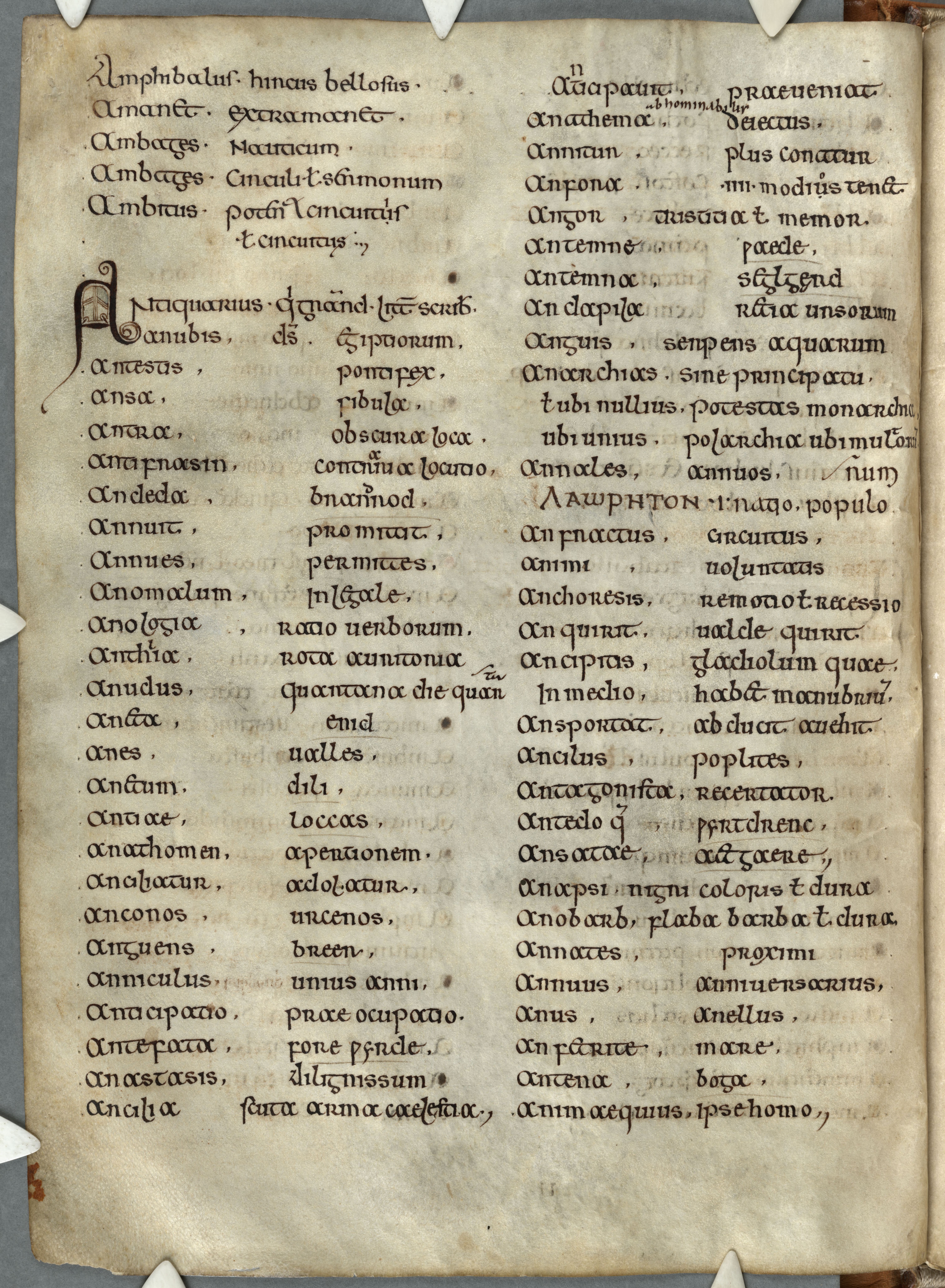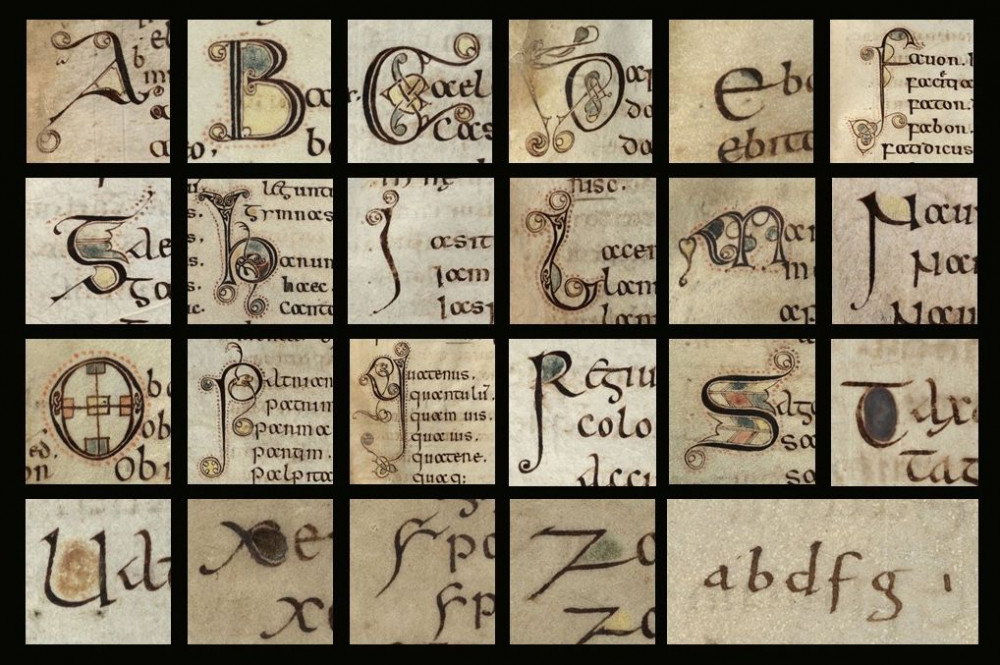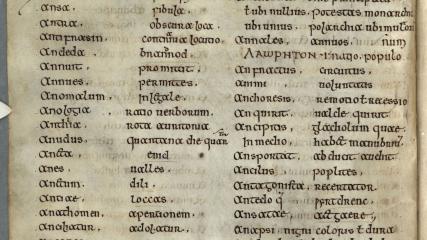Parker’s Anglo-Saxon Kingdoms: The Corpus Glossary (MS 144)
The Parker Library is proud to be the single largest lender of manuscripts to the British Library’s magnificent exhibition, Anglo-Saxon Kingdoms: Art, Word, War. In a series of blog posts spanning the Christmas holiday and into the New Year, we will shine a spotlight on a selection of the Parker manuscripts currently on display. Our first post profiled our magnificent Northumbrian Gospels (CCCC MS 197B), and this time we move forward a century in time to the turn of the ninth century, and journey South from North- to Southumbria to take a closer look at the fascinating Corpus Glossary, CCCC MS 144.
 The Corpus Glossary is a kind of alphabetical dictionary. Written in the early ninth century, it comprises a list of words with synonyms in Latin, Greek, and Old English, arranged in more-or-less alphabetical order by the words’ first two letters. Its particular importance lies in its inclusion of Old English. This volume is celebrated as the earliest substantial manuscript containing Old English. It contains several glossaries, and while most of the glosses are in Latin, there are over two thousand in Old English.
The Corpus Glossary is a kind of alphabetical dictionary. Written in the early ninth century, it comprises a list of words with synonyms in Latin, Greek, and Old English, arranged in more-or-less alphabetical order by the words’ first two letters. Its particular importance lies in its inclusion of Old English. This volume is celebrated as the earliest substantial manuscript containing Old English. It contains several glossaries, and while most of the glosses are in Latin, there are over two thousand in Old English.
Learning aids such as this appeared from the seventh century onwards, and are essentially the precursors of our modern dictionaries. Glossaries were designed to provide an explanation and perhaps a translation of a selection of terms. As such their content and provide valuable insight into the range of texts consulted by the Anglo-Saxons and the teaching of the schools during this period. In addition to our manuscript, other important early Anglo-Saxon examples of the genre, which appears to have been particularly developed and promoted by the Canterbury school, include the Leiden Glossary (apparently compiled in England between c.650 and 800 but copied later, c. 800, at the continental Insular centre of St. Gall, Switzerland), and the Epinal and Erfurt Glossaries.
The Corpus Glossary attests to ways and means of learning in England about half a century before Alfred entered the picture, and provides invaluable insight into Anglo-Saxon readers’ engagements with the wider world of Christian-Latin learning. The picture it paints is a familiar one, witnessing generations of readers encountering challenging texts and struggling with ‘difficult’ words. It is perhaps particularly comforting to receive an Anglo-Saxon reminder that none of us has all the answers, and that sooner or later we all encounter words that we don’t understand and whose meaning we have to look up in some suitable learning aid. Let’s take a closer look at this Anglo-Saxon example.
The opening displayed on exhibition shows the sections of the An– and Ap– entries, including two decorated ‘A’ initials marking the openings of these respective sections. The first of these, Antiquarius, on the left-hand page, defines an ‘antiquarian’ as one qui grandes litteras scribit, as one ‘who writes large script’; in other words, a person who used uncials, a description referencing Latin uncial script, whose large neat spacious characters became the handwriting of early Christianity, and witnessing uncials’ enduring association with antiquity and authority in the Middle Ages. It is followed by an entry for Anubus, recognisably defined as an ‘Egyptian god’ (deus Egiptiorum).
The second initial, on the right-hand page, marks the entry for Apodixen, defined as ‘a show or display’(fantasia uel ostentatio), but also provides the Latin translations for several familiar Old English words including ‘goose’(in Old English goos; Latin, Anser) and ‘eel’ (the Old English el, written Anguila in Latin).
Although this manuscript itself is quite short, in addition to the famous ‘Glossary’ (fols. 4r-64v), the volume includes two supplementary texts, both grammatical in subject: a copy of the ‘Interpretations of Hebrew and Greek Names’ (fols. 1r-3v), and an excerpt from an Irish manuscript of a treatise on grammar by Priscian (fl. c. 500) – the second book of his Institutiones grammaticae – written in Gaelic National Hand at a later date, probably in the twelfth century (fols. 65r-66v).
Like our Northumbrian Gospels, CCCC MS 197B, the Glossary is also from St. Augustine’s Abbey, Canterbury but unlike its Gospel book fellow which arrived there some time after it was first made, CCCC MS 144 was a child of Canterbury from birth, copied at the turn of the ninth century, quite probably in the scriptorium of St. Augustine’s itself. It is written in a beautiful Anglo-Saxon Hybrid Minuscule and features some typically Insular – and therefore gorgeous – decoration of initials, too delightful not to share, so I present a selection here for you to enjoy!
 The Corpus Glossary offers an endlessly fascinating work for the curious, as absorbing and entertaining as it is engaging and informative. For instance if we browse the volume in search of the language of books, we find any number of entries offering intriguing definitions for book-related words. We find books themselves variously defined as either a codex, or liber (in Latin) or in Old English as onheaƿas (codices). We discover that a ‘Library’ is called a Bibliotheca, here defined as a librorum reposio, or ‘a repository of books’, and learn that those who write books are known as Librarios (uidi [for uiri] qui libros scribunt), while those who sell books are termed Biblio pola (qui biblos uendit). These are but a few examples from the rich and revealing word-hoard of The Corpus Glossary. You have only to visit the exhibition to encounter this glorious manuscript and discover many more for yourselves – happy hunting!
The Corpus Glossary offers an endlessly fascinating work for the curious, as absorbing and entertaining as it is engaging and informative. For instance if we browse the volume in search of the language of books, we find any number of entries offering intriguing definitions for book-related words. We find books themselves variously defined as either a codex, or liber (in Latin) or in Old English as onheaƿas (codices). We discover that a ‘Library’ is called a Bibliotheca, here defined as a librorum reposio, or ‘a repository of books’, and learn that those who write books are known as Librarios (uidi [for uiri] qui libros scribunt), while those who sell books are termed Biblio pola (qui biblos uendit). These are but a few examples from the rich and revealing word-hoard of The Corpus Glossary. You have only to visit the exhibition to encounter this glorious manuscript and discover many more for yourselves – happy hunting!

